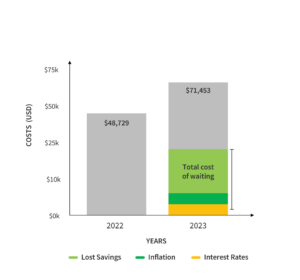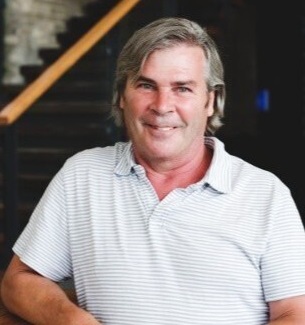
Leverage innovative funding solutions to close deals that didn’t make your customer’s budgets last year, and accelerate sales in 2023.
TL;DR
-
Your customers often face budget constraints, limited capital, and competing business priorities.
-
Leveraging on-bill funding that turns capital expenses into operating expenses removes sales blockers and closes deals.
-
Innovative funding solutions will push deals that didn’t close in 2022 across the line, and speed up your sales cycle.
Your customers want to lower their energy costs, and you know your solutions can help since they pay for themselves. Yet despite such a great fit, many deals never make it across the finish line because of up-front expenses and hesitation.
Capital limitations, perceptions of risk, and uncertainty all raise sales blockers that slow the adoption of clean technology. That said, overcoming these common sales objections is possible, by reframing energy efficiency projects as operating expenses, rather than capital expenses.
Learn more about unblocking customer barriers by signing up for our webinar, Beat clean energy sales objections and win your deals in 2023.
Deals are like hikers in winter, they need to keep moving to survive. Offering your customers the ability to repay your solutions with a percentage of their savings, protects their cash flow, bypassing the blockers that are holding back deals.
Customers are fighting for budget—paying with a percentage of savings solves this.
Companies want to invest in energy efficiency, but capital and a sense of urgency are often lacking. Private sector customers are often hesitant to incur capital expenses, and public sector projects come with long approval and bidding processes.
In both sectors, solution providers often face uncertain customers who aren’t familiar with the complexities of the energy efficiency space and express skepticism about a solution’s promised savings.
At the same time, energy efficiency projects have to compete with other budgeting priorities for limited resources. For example, expanding into new markets, increasing output, or upgrading critical production equipment often trumps energy projects in the fight for capital.
Waiting another year to (maybe) improve energy efficiency comes with real costs. For example, if a customer decided at the beginning of 2022 to purchase a building management system for $48,729, but delayed doing so until 2023, that price can increase by almost 50 percent.
Delaying the project racks up costs from high inflation ($2,924), rising interest rates ($2,054), and lost savings ($17,754). By waiting until 2023 to finally start the project, the cost has risen to $71,453. That’s an increase of $22,734 or almost half the original cost of the solution!

The opportunity cost of not acting goes beyond missed savings to include the squandered potential these savings could have unlocked. Hesitating steadily bleeds company coffers of funds that could be used to support the kinds of competing capital priorities mentioned above.
Consequently, demonstrating urgency and adding value, while making it as easy as possible for customers to act is vital for unblocking deals and increasing sales.
Make it as easy as possible for customers to say yes with percentage of savings funding
Overcoming your customer’s sales objections involves more than educating them about the cost of waiting. You need to provide them with easier alternatives to get projects moving.
For example, customers may know that paying with cash has pitfalls, such as tying up capital, but securing funding through traditional means presents new challenges that are just as difficult to overcome.
Faced with the choice, many companies will choose cash (or forgo a project all together) rather than have to deal with the hassle of budgeting capital expenses.
Cash flow is king, so minimizing outlays goes a long way towards overcoming hesitancy. Specifically, by using innovative funding solutions, companies can turn capital expenses into operating expenses.
Energy service agreements (ESA) allow customers to repay your solutions through a portion of the project’s savings, with no-upfront costs. The ESA provider funds project development and installation.
For your customers, this minimizes risk and guarantees savings (since repayment is tied to the solution’s performance), allowing them to start saving right away. It also converts the project into an operating expense, so you will bypass long procurement cycles in the public sector.
Crafting your pitches to include cash-flow positive repayment supports your customer champions as they navigate the approval process.
By doing away with the need to issue request for proposals (RFP) or provide ROI calculations, customers are provided with a compelling funding alternative. And none too soon, for as their energy expenses continue to mount, beginning a project becomes both more urgent and straightforward.
Clean technology’s momentum will only accelerate in 2023. Are you ready to capitalize on this momentum by unblocking your sales pipeline, shortening sales cycles, and making it easier for customers to choose your solutions?
Discover the key to closing more deals in 2023
Customers want to cut their energy costs, but were hesitant to part with capital in 2022. Traditional funding options are complicated, and are becoming more expensive due to rising interest rates.
With these problems at work, many did not want to risk making sense of the complex clean energy market.
Solution providers can unblock companies held back by these barriers by offering customers innovative funding options that protect cash reserves, so they can be used for other business priorities.
Percentage-of-savings funding options like ESAs remove upfront costs while helping customers stay cash flow positive. Solutions providers that highlight these benefits for their customers can bring more 2022 deals to completion and boost their 2023 sales.
Our upcoming webinar, Beat clean energy sales objections and win your deals in 2023, will prepare you to use the power of percentage-of-savings funding to overcome sales blockers and create a sense of urgency around your solutions.
The webinar is on February 22 at 11 a.m. Eastern. Sign up to join our CEO, Tomas van Stee, and Director of Finance, Corey Bonkowski as they help an audience of diverse solution providers leverage percentage-of-savings funding to sell more. We look forward to seeing you there!





